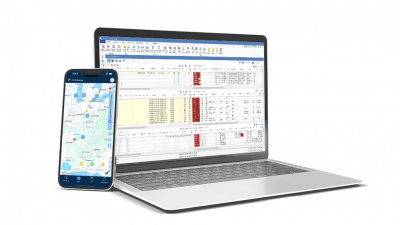Logistics and transportation are intricate fields where operational clarity and efficiency are often the difference between success and failure. Businesses recognize this — a staggering 98% of large and 83% of small companies turn to transportation management systems (TMS) as their strategic tool to streamline processes and enhance performance.
But what exactly is a TMS, and how does it improve your business? In this article, you’ll learn the essentials of transportation management systems, their functions and benefits, and how to choose the best TMS for your organization.
What Is a Transportation Management System (TMS)
Transportation management system software can help companies manage the movement of freight and goods more effectively. Businesses with a consistent need for shipping and receiving or the movement of freight, such as a commercial carrier, retailer, or manufacturer/distributor, can benefit from using a TMS.
The software simplifies numerous facets of the transportation process, including planning, execution, billing, and reporting.
A TMS can also integrate with your other technologies, such as your ERP, electronic logging devices, fuel card systems, and accounting software, to make transportation operations more efficient and cost-effective. It serves as a central hub coordinating various transportation activities and ensuring smooth communication between all parties.
Core Functions of a Transportation Management System
A TMS can offer various features to increase the efficiency of and visibility into your daily transportation operations. These functions provide visibility into your transportation business, automate multiple tasks, and provide strategic insights and operational control.
Here’s a look at a few of the core functionalities of a TMS and how each contributes to the optimization of your business’ transportation processes.
Order Management
A TMS helps manage and organize transportation orders, including order entry, consolidation, and optimization.
Load Planning and Optimization
A TMS can optimize loads by helping you choose the most cost-effective routes and modes of transportation. Load planning features consider factors such as freight characteristics, destination, and timelines to ensure efficient and cost-effective delivery.
A TMS can also facilitate carrier management to help businesses choose carriers that best meet their specific needs and criteria. The primary goal is to maximize load capacity and minimize transportation costs while adhering to delivery schedules and compliance requirements.
Load Execution
Booking and tendering processes are fundamental to operational success. A good TMS is a facilitator, making it easier to assign loads to carriers and drivers. It enables businesses to compare rates, assess carrier performance, and secure the most suitable transportation options. This component of a TMS ensures that each load is handled efficiently, from the initial booking stage to the final execution, aligning with the set timelines and cost parameters.
Billing and Payments
A TMS can also address the financial aspects of transportation, including settlement, auditing, and billing. These functions automate invoicing and payment processes to ensure accuracy and reduce administrative overhead. It also provides tools for auditing freight bills, identifying discrepancies, and ensuring compliance with contractual terms. The focus is on maintaining financial integrity and streamlining the payment lifecycle, from invoicing to revenue recognition.
Freight Tracking
Freight tracking is crucial to your transportation business and can be built into or integrated with your TMS. It offers real-time visibility into the status and location of shipments, enabling your business to monitor transit progress, anticipate delays, and communicate timely customer updates. This improves supply chain transparency, allowing expectations to be managed and proactively responding to transit challenges. Freight tracking is essential for maintaining control over the shipping process and ensuring reliable delivery performance.
Reporting and Analytics
Reporting and analytics in a TMS provide critical insights for strategic decision-making. Most TMS systems offer advanced analytics and the ability to track key performance indicators (KPIs). This information is crucial for continuous improvement and strategic planning, allowing businesses to identify trends, optimize operations, and make data-driven decisions for future transportation needs.

Benefits of a Transportation Management System
A transportation management platform (TMP) offers significant benefits to companies involved in logistics and shipping. The advantages of a TMP or TMS touch every aspect of transportation management. Here are some of the top benefits:
Saves Time and Money
Optimizing shipments with a TMS can save you time and money. A TMS reduces unnecessary mileage and fuel consumption by choosing the most efficient route and mode of transportation. Additionally, it streamlines carrier selection and rate negotiation processes to reduce freight expenses. This efficiency translates into lower operational costs and faster delivery times.
Streamlines Processes
A TMS is pivotal in simplifying logistical operations by acting as a central hub for managing freight audits, invoice processing, payments, and cost performance analysis. Centralizing these functions reduces the possibility of errors and allows teams to concentrate on more strategic initiatives rather than tedious tasks. A more efficient operation results in a more productive business.
Enhances Ongoing Performance
A TMS significantly boosts ongoing operational performance by offering real-time updates and detailed analytics. This functionality ensures that businesses have up-to-date shipment information, allowing for prompt responses to any logistical changes or challenges. A TMS also provides comprehensive reporting that enables experts to identify areas of improvement, reduce operational costs, and improve service quality.
Manual processes slowing down operations?
Discover 6 proven strategies to streamline operations, boost efficiency, and grow your trucking business in our on-demand webinar!
How to Choose Transportation Management Software: 9 Tips for TMS Success
Choosing the right TMS can have a significant impact on your logistics operations. To ensure the chosen TMS aligns well with your operational and long-term goals, approach this decision methodically. Here are some of our top tips broken down into key steps to help streamline your selection process.
1. Consider Your Goals
Begin by defining your logistical goals. What are you trying to achieve with a TMS? This could include objectives like cost reduction, process efficiency, improved customer service, or better data visibility. Clear goals will guide your search, allowing you to focus on TMS features most relevant to your business needs.
2. Analyze Your Current Systems
Choosing a TMS that integrates seamlessly with your current technology stack is important. Make sure prospective TMS solutions integrate well with existing systems, focusing on data transfer, user interfaces, and process alignment. The goal is to avoid integration challenges that lead to operational disruptions and costs.
3. Review Integration Capabilities
In addition to integrating smoothly with your current tech stack, your TMS should be ready to adapt to future technologies and systems. The availability of APIs, compatibility with emerging technologies, and the ability to adapt to new processes all play a crucial role in future-proofing your TMS and ensuring longevity and relevance.
4. Check Compliance and Security Features
Maintaining operational compliance and protecting sensitive data is crucial. Check the TMS’s data security measures, compliance with legal standards (such as GDPR, if applicable), and ability to handle confidential information securely. Robust compliance and security features are vital for safeguarding your business and maintaining customer trust.
5. Consider Scalability for Future Growth
Your TMS should accommodate changes as your business grows. Check for features like modular design, customizability, and the ability to handle increased transaction volumes or expand into new geographic regions. Your TMS should be scalable to remain a valuable tool for your business in the long run, preventing future system replacements.
6. Make a Shortlist
To identify TMS solutions that meet your business needs, conduct thorough research. Read reviews, seek industry peers’ recommendations, and examine various TMS options, then develop a shortlist of your top TMS options. Industry based review programs can provide additional insights as they have dedicated teams conducting extensive research. Using this shortlist, you can concentrate on the most promising options and streamline the selection process for more in-depth evaluation.
7. Evaluate Vendor Reputation and Support
Make sure to carefully examine the reputations of the vendors you’ve shortlisted. A vendor with a strong track record in your industry and positive customer feedback is more likely to provide a reliable and effective solution. In addition, look at customer service availability, training resources, and technical support. A vendor with excellent support will ensure a smooth transition and efficient problem-solving during and after TMS implementation.
8. Test Your Top Tools
Demos and trial periods are available from many TMS vendors. You can use the trials to evaluate how the software works in your workplace, how easy it is to use, and how well it integrates with your processes. Take note of how each system handles your specific logistics challenges and how intuitive the interface is to your team. You’ll be better able to choose the TMS that best suits your needs after gaining first hand experience.
9. Conduct a Cost-Benefit Analysis
Finally, perform a comprehensive cost-benefit analysis for your top tools. Consider the total cost of ownership, including initial setup costs, subscription fees, and potential savings in operational efficiency. Make sure you weigh these costs against the expected benefits, such as time savings, error reduction, and improved customer satisfaction. Using this analysis, you can select a TMS that meets your functional requirements and offers the best value.

PCS | TMS for Shippers and Carriers Unlocks the Power of a TMS
Selecting an appropriate TMS is crucial for any organization involved in logistics. PCS | TMS for Shippers and Carriers stands out as a provider of advanced TMS solutions, offering several options to suit the diverse needs of today’s businesses.
Choosing PCS means more than just implementing a TMS — it’s about accessing a comprehensive suite of tools designed to enhance and streamline your transportation management operations. Our TMS is built to introduce new efficiencies, create cost savings, and improve overall effectiveness.
Discover what a TMS can do for your business with PCS. Learn more about how we can help by requesting a demo for our TMS for Shippers or our TMS for Carriers to experience firsthand how our solutions can benefit your operations.



